The DN-1 Foundations I course features a brief introduction to the history of dry needling, trigger points, and myofascial pain, an in-depth review of possible adverse events, the OSHA Bloodborne Pathogen Standards within the context of dry needling, and an introduction to relevant pain sciences.
Many muscles commonly addressed in clinical practice are included, such as the infraspinatus, upper trapezius, deltoid, sternocleidomastoid, triceps, biceps, brachialis, levator scapulae, the latissimus dorsi (partially), the subscapularis, brachioradialis, wrist extensors, supinator and anconeus, the quadratus lumborum, psoas major, lumbar iliocostalis, the gluteal muscles (minimus, medius, and maximus), the hip adductor muscles, the quadriceps and hamstrings, and gastrocnemius and soleus muscles.
Students will review the anatomy, function, and dry needling techniques for each muscle.
Pre-Course videos will be provided after registration. You can register for the DN-1 Webinar If you prefer to review the presentations in a live webinar.
Dry Needling 1: Foundations I is the first course in a 3-course series offered by Myopain Seminars to attain certification as a Certified Myofascial Trigger Point Therapist – Dry Needling (CMTPT/DN).
A minimum score of 70% on a multiple choice quiz plus demonstrated muscle competency is required to pass this course. Physical therapists licensed in Tennessee must achieve a minimum score of 80%.
Several states require between 46 and 54 hours of dry needling education to be able to use dry needling in clinical practice, which makes some students conclude that attending the DN-3 course would not be needed. In one of our blogs, we explain the clinical and legal considerations why clinicians should complete the entire certification program in dry needling,

